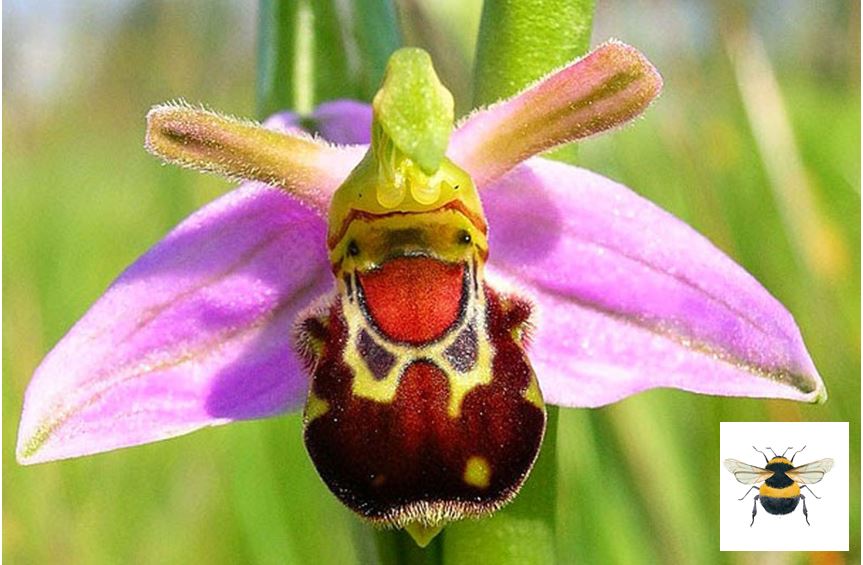Ophrys apiflora (Orchidaceae)
ചിരിക്കുന്ന പെരുംതേനീച്ച എന്നു വിളിക്കപ്പെടുന്ന ഒരു ഓർക്കിഡ് ഉണ്ട്. ആൺ തേനീച്ചകളെ പറ്റിച്ചു സ്വന്തം പരാഗണം നടത്തിക്കുന്ന ഒരു വിരുതൻ..!! കേട്ടിട്ടുണ്ടോ?
മദ്ധ്യ-ദക്ഷിണ യൂറോപ്പിലും, വടക്കേ ആഫ്രിക്കയിലും, പടിഞ്ഞാറൻ ഏഷ്യയിലുമാണ് വംശനാശഭീഷണി നേരിടുന്ന ഈ സസ്യം വളരുന്നത്.
ഒരു ഡസനോളം പൂക്കളാണ് ഇതിന്റെ പൂക്കുലയിൽ ഉണ്ടാകുന്നത്. പർപ്പിൾ നിറത്തിലുള്ള മൂന്ന് വിദളങ്ങൾക്ക് (sepals) നടുവിലായി, ഒരു തേനീച്ചയുടെ ആകൃതിയിലാണ് മൂന്ന് ദളങ്ങൾ ഇരിക്കുന്നത്. മുകളിലെ രോമാവൃതമായ രണ്ടെണ്ണം തേനീച്ചകളുടെ സ്പർശിനിയെ (antenna) പോലെയും, മധ്യഭാഗത്തുള്ളതു (labellum) വീർത്തു ശരീരം പോലെയും തോന്നിക്കുന്നു. അതിൽത്തന്നെ ഒരു ചുവന്ന ‘ചിരിക്കുന്ന രൂപവും’ നമുക്ക് കാണാം.
പൂക്കൾക്ക് പെൺ തേനീച്ചകളുടെ രൂപം മാത്രമല്ല, ഗന്ധവും ഉള്ളതിനാൽ, തെറ്റിദ്ധരിക്കപ്പെടുന്ന ആൺ തേനീച്ചകൾ പൂക്കളുമായി ‘ഇണ ചേരുന്നു’. പറ്റിക്കപ്പെട്ടെന്ന് തിരിച്ചറിയുമ്പോഴേക്കും മുകൾ ഭാഗത്തു നിന്നും ഉന്തിനിൽക്കുന്ന പൂമ്പൊടി നിറഞ്ഞ സഞ്ചി (pollinia) മുതുകത്തു ഒട്ടിപ്പിടിച്ചിട്ടുണ്ടാവും. അതുമായി മറ്റൊരു പൂവിലേക്ക് എത്തുമ്പോൾ, കൊണ്ടു ചെന്ന പൂമ്പൊടി വീണ് അതിന്റെ പരാഗണം നടക്കും. എത്ര മനോഹരമായ ‘പറ്റിക്കൽ‘ അല്ലേ..!!?
‘തെറ്റിദ്ധരിപ്പിച്ചുള്ള പരാഗണത്തിന്റെയും’ (deceptive pollination), സസ്യങ്ങളും പരാഗണഹേതുക്കളായ പ്രാണികളും തമ്മിലുള്ള അഭേദ്യമായ ബന്ധത്തിന്റെയും (plant-pollinator relationship), സഹ പരിണാമത്തിന്റെയും (co-evolution) ഉത്തമദൃഷ്ടാന്തമാണീ പുഷ്പം.
Ophrys apifera is an endangered, perennial herbaceous plant, found across central and southern Europe, as well as North Africa and the Middle East.
The flowers have 3 large, purple petalloid sepals. The actual short pubescent petals lie just above the sepals, protruding laterally from the green central column. The third trilobed petal (labellum), with two lateral humps and a hairy colourful median lobe mimic the abdomen of a bee, which also acts as a landing pad for them.
Male bees (Eucera sp.) attempt to copulate with the flowers, which resemble female bees and which also emit ‘allomones’ that mimic the scent of the female bees. During this pseudocopulation, the pollinia stick to the bee.
Hence, the flower serves as an example of ‘sexually deceptive pollination’ and ‘floral mimicry’, as well as of a highly selective and highly evolved plant–pollinator relationship.

